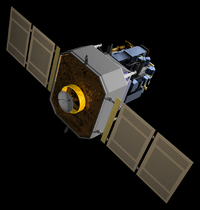
Photo from wikipedia
Predictions of the arrival of four coronal mass ejections (CMEs) in geospace are produced through use of three CME geometric models combined with CME drag modeling, constraining these models with… Click to show full abstract
Predictions of the arrival of four coronal mass ejections (CMEs) in geospace are produced through use of three CME geometric models combined with CME drag modeling, constraining these models with the available Coronagraph and Heliospheric Imager data. The efficacy of these predications is assessed by comparison with the Space Weather Prediction Center (SWPC) numerical MHD forecasts of these same events. It is found that such a prediction technique cannot outperform the standard SWPC forecast at a statistically meaningful level. We test the Harmonic Mean, Self-Similar Expansion, and Ellipse Evolution geometric models, and find that, for these events at least, the differences between the models are smaller than the observational errors. We present a new method of characterizing CME fronts in the Heliospheric Imager field of view, utilizing the analysis of citizen scientists working with the Solar Stormwatch project, and we demonstrate that this provides a more accurate representation of the CME front than is obtained by experts analyzing elongation time maps for the studied events. Comparison of the CME kinematics estimated independently from the STEREO-A and STEREO-B Heliospheric Imager data reveals inconsistencies that cannot be explained within the observational errors and model assumptions. We argue that these observations imply that the assumptions of the CME geometric models are routinely invalidated and question their utility in a space weather forecasting context. These results argue for the continuing development of more advanced techniques to better exploit the Heliospheric Imager observations for space weather forecasting.
Journal Title: Social Work
Year Published: 2017
Link to full text (if available)
Share on Social Media: Sign Up to like & get
recommendations!